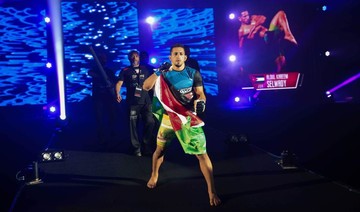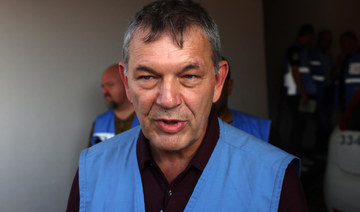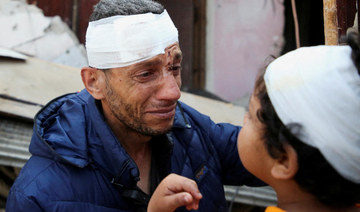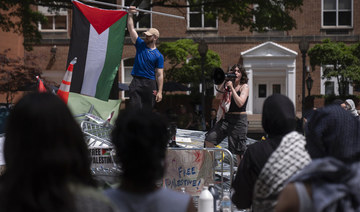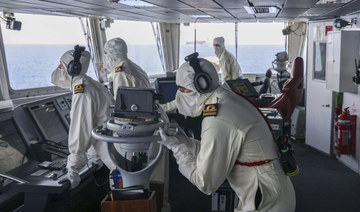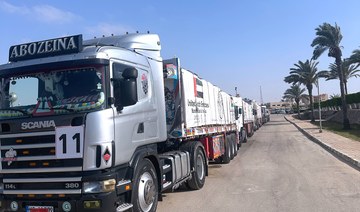GAZA CITY, Gaza Strip: When Mazen Al-Dalo took two of his young sons to see the Palestinian protests against Israel’s decade-old blockade of Gaza, he knew it could be dangerous.
Rock-throwing demonstrators were being shot by Israeli soldiers, and armored Israeli jeeps were firing endless volleys of tear gas into the crowds.
But it was important to teach the boys about Palestinian history, he said, and give them a glimpse of the modern-day struggles their people face. “Seeing things with your own eyes is different than reading about them in books,” the 44-year-old father said, explaining his decision to take the children, aged 8 and 11, one day last April.
The family only ventured about 400 meters (yards) from the border — a spot Al-Dalo believed was safe, away from the violent confrontations. But just as he pointed to a group of Israeli soldiers atop a berm on the other side of the Israeli fence, a single gunshot rang out.
The round ripped off Al-Dalo’s thumb and struck his 8-year-old son, Mohamed, in the leg — two more casualties in a simmering conflict that began last spring and has seen a staggering 948 Palestinians under the age of 18 shot and wounded by Israeli forces, according to the United Nations.
In a statement, Israel’s military said it does “everything possible to avoid harming children.” But Hamas, the militant group that rules Gaza, “cynically uses Gaza residents, especially women and children, as human shields and places them at the forefront of the violent riots.”
Hamas, which has orchestrated the demonstrations, denies such allegations. Hazem Qassem, a Hamas spokesman in Gaza, said “there is no way to prevent the people from participating. There are entire families (who go) and there is no way to prevent them.”
Ever since the demonstrations began in March, children have been a constant presence among the surging crowds — some hurling stones with slingshots or burning tires, others merely watching from afar. While many are brought by parents who hold their hands and carry them on their shoulders, others make their way on their own.
Of the 175 Palestinians killed so far, at least 34 were 18 or under, according to an Associated Press count. Gaza’s Health Ministry says 2,295 minors have been hospitalized, 17 of whom have had a limb amputated; at least 5,124 have been injured in all.
Young victims are not a new phenomenon in the region. In the first Palestinian uprising that began in 1987, children and teens often threw stones at Israeli soldiers, who frequently responded with live rounds. According to the Israeli human rights group, B’Tselem, minors comprised about 21 percent of deaths back then. In the latest protests, that percentage is roughly the same.
The Israeli military, which deploys snipers atop pyramid-shaped bunkers positioned at regular intervals along the frontier, says it takes pains to avoid civilian casualties and only uses live fire as a last resort. But it also says it must defend against “terrorist” crowds hurling grenades and firebombs, and stop those who penetrate or damage the fence.
Amnesty International and other human rights groups argue that under international law, the use of live ammunition can only be justified in the face of imminent death or serious injury. Israel argues that is exactly what its forces face. One Israeli soldier was killed by a Hamas sniper during a demonstration last July, and at least six have been wounded.
Video images circulating on social media, however, have also shown unarmed protesters being shot, including some struck while running away or waving the Palestinian flag, Amnesty said. One incident in September showed a 16-year-old boy being shot in the chest while waving his hands in the air; he had just hurled a stone toward the fence, but it’s unclear if it had even reached it.
After another teen was shot dead in April, UN envoy Nickolay Mladenov asked in a tweet: “How does the killing of a child in #Gaza today help #peace?” Mladenov answered his own question, saying “It doesn’t! It fuels anger and breeds more killing.”
The protests have been fueled by desperate living conditions in Gaza, a place most residents are prohibited from leaving. More than a decade since Israel and Egypt imposed the blockade on Gaza, unemployment is over 50 percent, tap water has become undrinkable and electricity is sporadic. Israel says the blockade is necessary to prevent Hamas from importing weapons.
When the demonstrations began, Raed Abu Khader told his 12-year-old son Mohammed to stay away, and the boy promised he would. But on Aug. 24, Khader received an urgent phone call from a friend: Mohammed had been shot in the leg at one of the demonstrations held that day.
“He shouldn’t have been there,” Abu Khader said of the boy, who has been unable to move his left leg since and fears it will be amputated. “But the Israelis should only be shooting to scare children off — not hit them.”
It’s unclear what Mohammed was doing when the shooting took place. Speaking in a wheelchair surrounded by friends on a Gaza street, he boasted that he had just hung a Palestinian flag on the fence when gunfire rang out. Later, lying in his darkened home with his distraught father looking on, the teen could not answer when asked where he was. Staring at the ground, his brown eyes welled with tears.
Abu Khader said the boy had been transported to the protest site via one of the Hamas-organized buses that park outside Gaza’s mosques every Friday. At the end of the ride was a spectacle that is consistently part-war, part-festival: cultural shows, corn on the cob, balloons and Palestinian kites laden with trails of flaming embers meant for Israeli farms. Plus the weekly confrontation itself: Palestinians armed with stones and firebombs battling armed Israeli forces flying spider-like drones equipped with tear gas.
“They see their friends going, and they want to go,” Abu Khader said. “They think it’s a game. They think they’re going to have fun. They don’t know how dangerous it is.”
The round that struck Mohammed Abu Khader severed the nerves in his leg so completely, he can neither feel nor move his limb at all. If he does not get out of Gaza, his 39-year-old father says, he will likely lose his leg.
Today, the boy often cries. He no longer goes to school. His father says the boy feels useless.
Mohammed Al-Dalo, the boy whose father took him to the protest, has been similarly traumatized. His father said he is markedly quieter now.
And like Mohammed Abu Khader, his life may be changed forever.
At a clinic run by Doctors Without Borders, physiotherapist Eyad Abedelaal says Mohammed Al-Dalo suffers from “foot drop.” Nerve damage means he cannot move his toes up and down; the boy limps when he walks.
They will try to perform another surgery to fix the problem. “But unfortunately, this kind of nerve damage will likely last forever,” Abedelaal said. “It means to walk correctly, he’ll probably need special shoes for the rest of his life.”
Mohammed’s father, Mazen Al-Dalo, says the boy asked to go back to the protests, but he refused because he doesn’t want him to get hurt again.
Still, he has no regrets. “This is the tax you have to pay to achieve the right of return,” he said, referencing a deep-held desire to take back land that hundreds of thousands of Palestinians fled or were forced from seven decades ago after the war that created Israel. “Nothing is free. We all have to sacrifice.”
For Palestinian children in Gaza, an education in conflict
For Palestinian children in Gaza, an education in conflict

- In the first Palestinian uprising that began in 1987, children and teens often threw stones at Israeli soldiers, who frequently responded with live rounds
- Amnesty International and other human rights groups argue that under international law, the use of live ammunition can only be justified in the face of imminent death or serious injury
Hezbollah fires rockets at Israel after south Lebanon strike kills 4 members of family
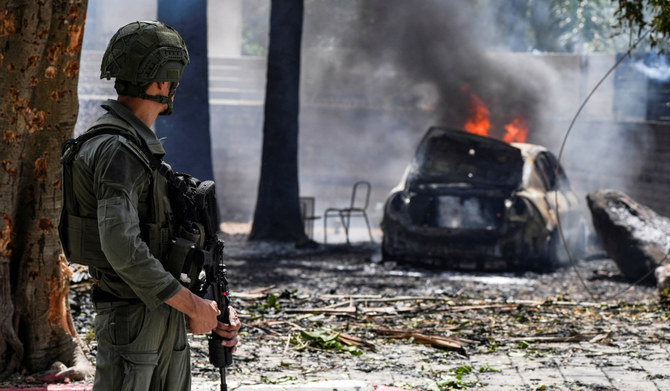
- Shells fall on Kiryat Shmona and reach northern Golan
- Maronite Patriarch Bechara Al-Rahi calls for end to war in southern Lebanon
BEIRUT: An Israeli airstrike killed four members of a family in a border village in southern Lebanon on Sunday, security sources said.
Hezbollah, in retaliation, fired Katyusha rockets at the northern Israeli town of Kiryat Shmona, close to the Lebanese border.
The four family members killed in Mays Al-Jabal were identified as Fadi Hounaikah and Maya Ali Ammar, and their sons Mohammed, 21, and Ahmad, 12.
The attack occurred when the family took advantage of a de-escalation of hostilities between Hezbollah and Israel to return to their properties to assess damage and move goods from their supermarket to a location outside the village.

A security source in the area told Arab News that while the family was gathering their groceries from the supermarket, an Israeli military drone spotted them and launched an attack, destroying the area and killing all the members of the family and injuring several civilians in the vicinity.
The source clarified that villages in the area were empty because “residents fled the area seven months ago.”
He added: “When residents want to enter these villages to attend victims’ funerals, they send their names and car number plates to the Lebanese Army and UNIFIL, who in turn coordinate with the Israeli side to spare these funerals (from attack).
“In general, people cannot enter border villages without taking into consideration the Israeli danger, as Israeli reconnaissance planes and drones are hovering over the area 24/7. However, what Israel committed against this family is a terrible massacre.”
Hezbollah responded to the incident by launching dozens of Katyusha and Falaq missiles at Israel. The group said the operation was “in response to the crime committed by Israel in the Mays Al-Jabal village.”
The Israeli Upper Galilee Regional Council announced that missiles hit buildings in Kiryat Shmona, while Israeli Army Radio reported that some of the rockets fell inside the city, causing a power outage.
An Israeli army spokesman reported that 65 rockets were launched from southern Lebanon toward Israeli settlements in the Upper Galilee region.
Meanwhile, Israeli airstrikes hit the villages of Al-Adissa and Kafr Kila, while artillery shelling hit the village of Aitaroun.
Maronite Patriarch Bechara Al-Rahi in his Sunday sermon called for an end to the war in southern Lebanon, urging an end to the “demolition of homes, the destruction of shops, the burning of the land and its crops, and the killing and displacement of innocent civilians and the destruction of their livelihood in an economic condition that has already impoverished them.”
Mohammed Raad, leader of Hezbollah’s parliamentary bloc, meanwhile, expressed his disapproval of the West’s backing for Israel.
He said that Israel “faces no international deterrent. On the contrary, some support it in committing crimes.”
He accused those who support Israel of being “hypocrites and liars who falsely claim to champion human rights, civilization, and progress in the West, (yet) they provide Israel with financial aid, weapons, smart bombs, and a continuous air bridge.”
Raad concluded: “We are not afraid of Israel’s insanity. We are prepared to confront them directly. We are prepared to sacrifice and shed blood to protect our homeland, independence, and honor.”
UNRWA chief says again barred entry to Gaza by Israel
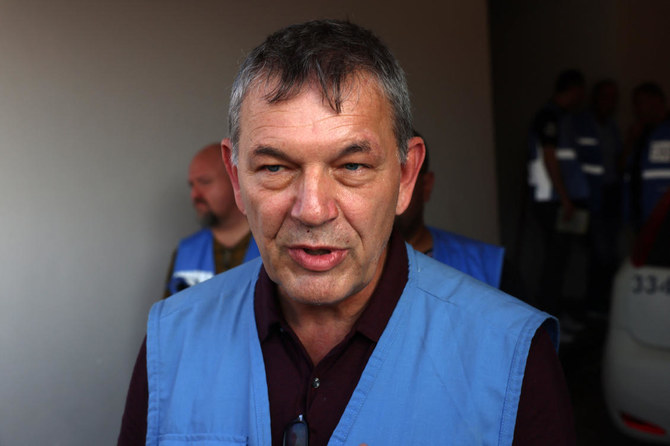
- “Just this week, they have denied — for the second time — my entry to Gaza where I planned to be with our UNRWA colleagues including those on the front lines”: Lazzarini
JERUSALEM: The head of the UN agency for Palestinian refugees, UNRWA, said Sunday that Israeli authorities had barred him from entering Gaza for a second time since the Israel-Hamas war started on October 7.
“Just this week, they have denied — for the second time — my entry to Gaza where I planned to be with our UNRWA colleagues including those on the front lines,” Philippe Lazzarini wrote on X, formerly Twitter.
Lazzarini has been to Gaza four times since the war broke out including on March 17.
“The Israeli authorities continue to deny humanitarian access to the United Nations,” he said on Sunday.
“Only in the past two weeks, we have recorded 10 incidents involving shooting at convoys, arrests of UN staff including bullying, stripping them naked, threats with arms & long delays at checkpoints forcing convoys to move during the dark or abort,” Lazzarini said.
He also called for an “independent investigation” into rocket fire that led to the closure of a key Israel-Gaza aid crossing.
Hamas’s armed wing, Ezzedine Al-Qassam Brigades, claimed responsibility for the Sunday launch, saying militants had targeted Israeli troops in the area of Kerem Shalom crossing.
Houthis claim Red Sea victory against US Navy

- Militia forces lack technical or military capability to achieve their objectives in the Mediterranean, analyst says
AL-MUKALLA: The Houthis have reiterated a warning of strikes against ships bound for or with links to Israel — including those in the Mediterranean — as they claimed victory against the US Navy in the Red Sea.
The Houthi-controlled SABA news agency reported that the fourth phase of the militia’s pro-Palestine campaign would involve targeting all ships en route to Israel that came within range of their drones and missiles, noting that the US, UK, and other Western navies “stood helpless” in the face of their attacks.
“The fourth phase demonstrates the striking strength of the Yemeni armed forces in battling the world’s most potent naval weaponry, the American, British and European fleets, as well as the Zionist (Israel) navy,” SABA said.
Houthi military spokesman Yahya Sarea said on Friday strikes against Israel-linked ships would be expanded to the Mediterranean. Attacks would be escalated to include any companies interacting with Israel if the country carried out its planned attack on the Palestinian Rafah.
Since November, the Houthis have launched hundreds of ballistic missiles and drones at commercial and navy vessels in the Red Sea, Bab Al-Mandab Strait and the Gulf of Aden. They claim attacks are only aimed at ships linked with Israel in a bid to force an end to its siege on the Gaza Strip.
They have also fired at US and UK commercial and navy ships in international waters off Yemen after the two countries launched strikes against Houthi-controlled areas.
On Saturday, Houthi information minister Dhaif Allah Al-Shami claimed the US was forced to withdraw its aircraft carrier and other naval ships from the Red Sea after failing to counteract attacks. He added new offensives would begin against Israeli ships in the Mediterranean in the coming days.
“They failed badly. Yemeni missiles and drones beat the US Navy, and its military, cruisers, destroyers and aircraft carriers started to retreat from our seas,” Al-Shami said in an interview with Lebanon’s Al-Mayadeen TV news channel.
Yemen specialists have disputed Houthi assertions that they have military weapons capable of reaching Israeli ships in the Mediterranean.
Brig. Gen. Mohammed Al-Kumaim, a Yemeni military analyst, told Arab News on Sunday the Houthis would only be able to carry out such attacks if they had advanced weaponry. He said the Houthis were expanding their campaign against ships to avoid growing public resentment in areas under their control after the militia had failed to pay public employees and repair services.
Al-Kumaim added the Houthis might claim responsibility for an attack on a ship in the Mediterranean which was carried out by an Iran-backed group operating in the region.
“Theoretically and technologically, the Houthis lack any technical or military capability to achieve their objectives (in the Mediterranean),” Al-Kumaim said.
Jordanian-Iraqi economic forum begins at Dead Sea resort

- A specialized session will focus on investment prospects in various economic sectors
AMMAN: Jordanian Minister of Investment Kholoud Saqqaf opened the Economic Forum for Financial, Industrial, and Commercial Partnerships between Iraq and Jordan on Sunday.
The forum, which is organized jointly by the Iraqi Business Council in collaboration with the Jordan and Amman chambers of industry, aims to strengthen economic ties between the two countries.
Held at the King Hussein Convention Center on the shores of the Dead Sea, the forum is the largest regional gathering for fostering economic cooperation between Jordan and Iraq, Jordan News Agency reported.
Over two days, the event will promote regional integration by facilitating economic connectivity and encourage collaboration across sectors.
Discussions will cover investment opportunities in Jordan and Iraq, prospects for commercial and industrial ventures, economic modernization initiatives, and opportunities in Jordan’s free and development zones.
Key figures attending include Kamel Dulaimi, the Iraq president’s chief of staff, ministers from Jordan and Iraq, as well as business leaders, investors and representatives from Arab and foreign companies.
Discussions are expected to focus on the banking sector’s role in providing financial support, while highlighting success stories from investment companies in both countries.
A specialized session will focus on investment prospects in various economic sectors, with a particular emphasis on mining and industry.
At the opening, Saqqaf highlighted investment prospects displayed on the Invest in Jordan platform, which align with the kingdom’s Economic Modernization Vision.
Meanwhile, Iraqi Minister of Industry and Mineral Resources Khaled Battal Al-Najm drew attention to his country’s industrial strategy and plans for a joint economic zone with Jordan, alongside efforts to address unemployment and attract foreign investment, especially in mining.
Dulaimi emphasized the significance of Iraqi President Abdul Latif Rashid’s recent visit to Jordan, underscoring discussions aimed at strengthening ties and enhancing economic systems to facilitate investment projects.
UAE delivers 400 tonnes of food aid to Gaza
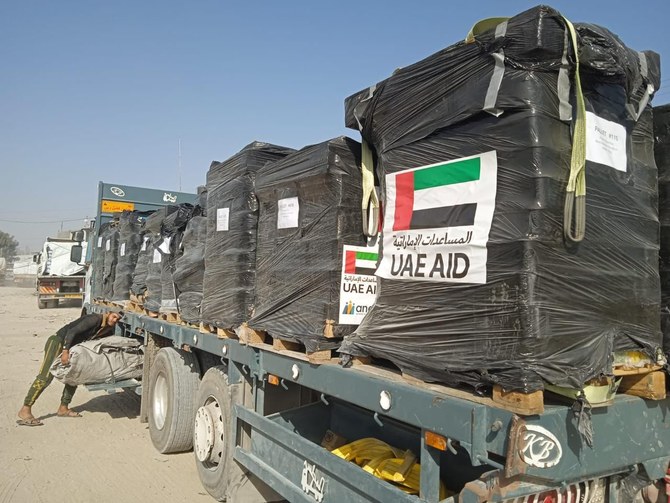
- Delivery, specifically for the northern areas of the enclave, is enough to feed about 120,000 people
DUBAI: The UAE, in partnership with American Near East Refugee Aid, announced on Sunday that it had delivered 400 tonnes of food aid to Gaza.
The delivery, specifically for the northern areas of the enclave, is enough to feed about 120,000 people, Emirates News Agency reported.
Reem Al-Hashimy, Emirati minister of state for international cooperation, said: “The UAE’s safe and successful delivery and distribution of food relief to the Gaza Strip, especially the northern Gaza Strip, marks a significant scaling up in action.”
She continued: “We remain firmly committed to our position of solidarity with the brotherly Palestinian people and alleviating suffering in the Gaza Strip. The UAE, working in parallel with international partners, is determined more than ever to intensify all efforts to ensure that aid lifelines get to those who need it the most.”
Sean Carroll, CEO of ANERA, thanked the Emirati government for its assistance in getting the much-needed aid to the Palestinian people.
“ANERA and the people we serve are extremely grateful for support from the government and people of the UAE, that allows us to deliver this food to northern Gaza, where the needs are so great,” he said.
Last month the UAE allocated $15 million under Cyprus’s Amalthea Fund to bolster aid efforts in Gaza.
Meanwhile, the Gulf country continues to collaborate with international partners and organizations to enable the effective delivery of food and relief via land, air and sea.
To date, the UAE has dispatched more than 31,000 tonnes of humanitarian supplies, including food, relief items and medical supplies, using 256 flights, 46 airdrops, 1,231 trucks, and six ships.
The UAE has embarked on several sustainable relief projects to ensure a consistent supply of food and water to the people of Gaza.
These initiatives include the establishment of five automatic bakeries, the provision of flour to eight existing bakeries, and the installation of six desalination plants with a combined capacity of 1.2 million gallons of water a day.



